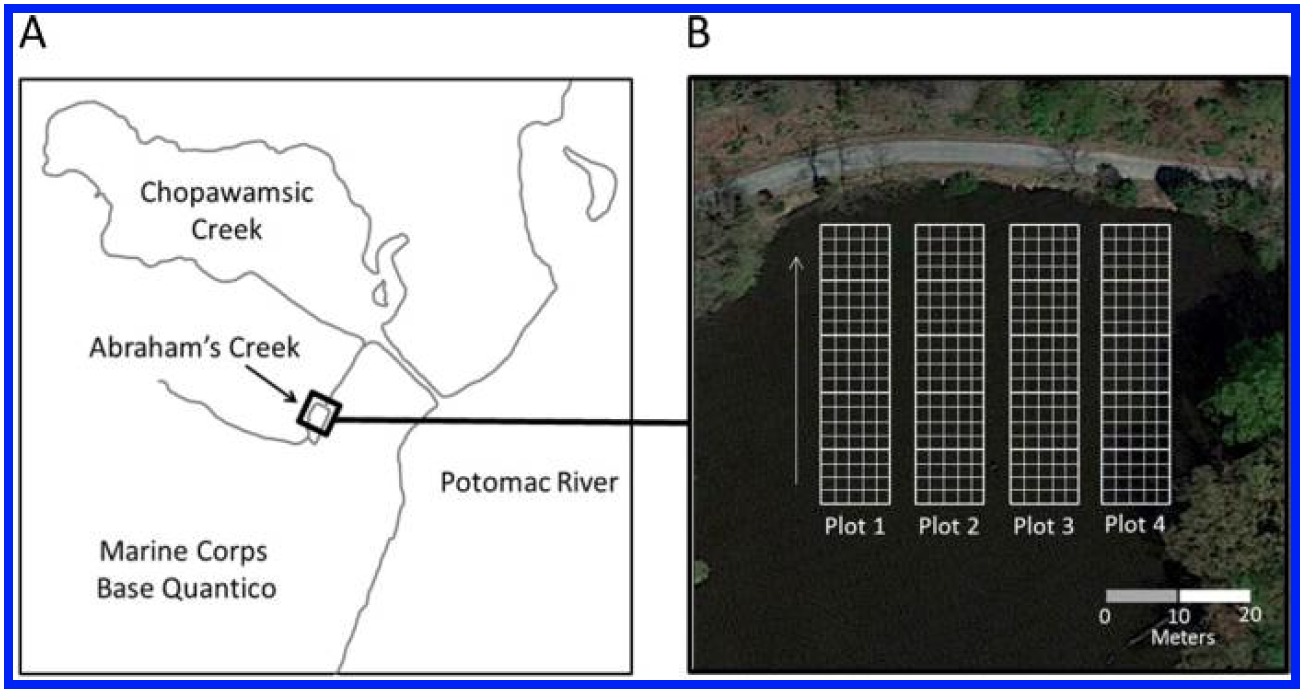
Scientists applying the bioamended AC to research plots. Credit: Kevin Sowers.
Polychlorinated biphenyls (PCBs) were used extensively in building materials and electronic transformers until their ban in 1979. PCBs are persistent carcinogenic compounds that bioaccumulate in aquatic and terrestrial environments and are frequently cause for fish consumption advisories across the US. Managing these compounds has been the center of many engineering efforts for decades, but a new approach developed by researchers at University of Maryland Baltimore County (UMBC) has proven to be an effective technique in PCB degradation. Their findings were recently published in Environmental Science and Technology.
While dredging and capping are often used to control PCBs, these can disturb ecosystems and potentially cause further harm. For two decades, Upal Ghosh of UMBC has been studying the use of activated carbon (AC) to reduce the bioavailability of toxics, but ultimately a more desirable goal is to break down the PCBs and prevent them from accumulating in the food chain. To do that, researchers have been looking at microbes that respire PCBs instead of oxygen. “When these microorganisms respire PCBs, a process known as halorespiration, they remove chlorines,” explained Kevin Sowers, the microbiologist from the Institute of Marine and Environmental Technology (IMET) on the team. “Once enough chlorines are removed, another group of microorganisms, aerobes that use oxygen, can then break the ring structure and further break down the PCBs.”
Other studies have used AC as a medium to deliver the microorganisms into sediment in the lab, but until now it had never been applied in the field.

Figure 1 from their recently published paper shows their 4 test plots in Abraham’s Creek.
UMBC researchers Ghosh, Sowers, and Hal May, among others, made up an unusual team of engineers and microbiologists that was able to scale up the technology and design the first field study of AC “bioamended” with microorganisms as a treatment for PCBs. They set up four plots in Abraham’s Creek, an offshoot of the Chopawamsic Creek and the Potomac River. The first plot was used as a control, the second was applied with just AC, and plots three and four were applied with the AC with microorganisms.
The team found a significant difference between plots three and four versus plots one and two. In plot two, which received only AC, the PCB levels in sediment samples were comparable to plot one, the control. Plots three and four had significantly lower PCB concentrations in the sediments in the top 7.5 cm. The researchers noted that the reduction effect was only seen in the shallower sediments because that is where natural mixing is happening. “That’s where we need to treat,” explained Ghosh, who added that PCBs deeper down in the sediments have less of a chance of ending up in organisms. In order to reach PCBs deeper down, researchers could use mechanical mixing, but that is not always the best methodology. “It’s a balance between what’s achievable with mixing, causing minimal disturbance, and getting the deeper PCBs out. It just depends on the site,” added Ghosh.

A visualization of how the researchers applied the bioamended AC to their research sites.
The researchers carefully monitored the native microorganisms and found that the applied microbes had no effect on the native community. Ghosh explained that the PCB-dechlorinating microbes “aren’t making a great living out there”- adding that they decline over time and degrade PCBs at a very slow rate. Sowers explained, “All the components of the system are naturally occurring… the microorganisms that we use are naturally occurring, non-recombinant and have no pathogenic properties that we know of, so we there is no apparent down side.”
The team saw large reductions in dissolved PCBs within the treated sediments. They also took surface water samples at their plots and found that the application did not reduce PCBs in the water column. This is likely because their plots were very small relative to the size of the creek: The creek is an 8-acre site, and each plot is only 1/10th of an acre in area. The water is well-mixed, so the effect of reducing PCB concentration in the sediment plots had little effect on PCB concentration in the water. Ghosh noted that treating the sediments would lead to a proportionate decrease of PCBs in the water, if this methodology were to be scaled up to the entire contaminated site.
Government agencies are eager to take these treatments to the next level. This study was funded by the Department of Defense through a program focused on developing environmental cleanup technologies and was conducted at a Marine Corps base. The Delaware Department of Natural Resources is also interested in applying this methodology to a state site.

Researchers preparing the bioamended AC. Credit: Sowers.
In the future, the team is excited to continue field trials. “Based on data from other studies we conducted, 3-4 years are required to achieve 80% or more degradation,” explained Sowers, who would like to monitor long-term effects of these applications. This research also has impacts for the entire Chesapeake Bay. “Many of the tributaries of the Chesapeake Bay have similar systems that have pollutants like PCBs,” said Ghosh. “Reducing the sources of these contaminants would lower the loads of PCBs into the Bay.”
